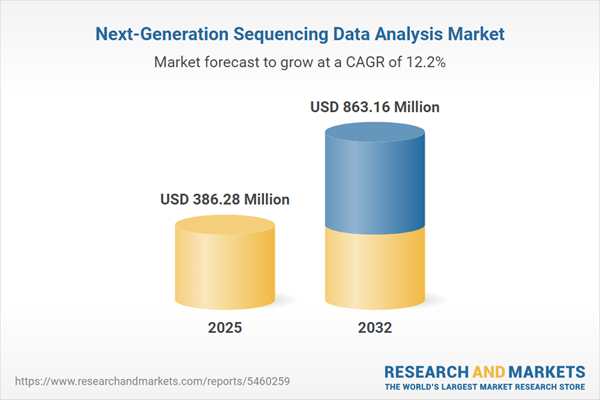Speak directly to the analyst to clarify any post sales queries you may have.
The next-generation sequencing data analysis market is at the center of strategic transformation for senior leaders in life sciences and healthcare, providing essential capabilities to turn complex molecular information into actionable insights that support organizational innovation and efficient decision-making.
Market Snapshot: Next-Generation Sequencing Data Analysis Market
In 2024, the global next-generation sequencing data analysis market is valued at USD 343.85 million, with projections indicating a rise to USD 386.28 million by 2025 and a further expansion to USD 863.16 million by 2032. This reflects a compound annual growth rate (CAGR) of 12.19%. Key drivers of this growth include strong investment, the transition toward digital methodologies, and rapid adoption of advanced analytics platforms designed for greater data complexity. The emergence of automated interpretation tools and improved solutions for data sharing are supporting research and clinical teams in translating molecular insights more efficiently, leading to faster implementation of discoveries and better operational results.
Scope & Segmentation
- Product Types: Consumables and reagents—such as preparation kits, flow cells, and specialty chemicals—form the foundation of reliable laboratory operations. Sequencing instrumentation offerings range from benchtop systems suitable for targeted research applications to high-throughput platforms tailored for extensive investigations. Bioinformatics and analytics services further enhance diagnostic workflows, supporting a wide spectrum of scientific and clinical objectives with increased accuracy.
- Application Areas: The market spans genomics, epigenomics, transcriptomics, metagenomics, and personalized medicine. Use cases include chromatin mapping, methylation analysis, rare disease detection, and oncology diagnostics. Adoption across these domains elevates scientific rigor and equips organizations to support integrated health management programs.
- End Users: The landscape is shaped by academic institutions, healthcare providers, contract research organizations, pharmaceutical leaders, and biotechnology firms. These stakeholders rely on sequencing analytics to drive research initiatives, enhance diagnostic precision, and deliver scalable precision medicine strategies that align with organizational goals.
- Geographic Regions: North America demonstrates continued leadership based on advanced technological infrastructure and robust investment. Europe and Asia-Pacific are gaining momentum, influenced by evolving regulatory frameworks and collaborative multi-country projects. In the Middle East and Africa, increasing access to sequencing solutions is fostering broader participation from emerging economies.
- Key Companies Profiled: Illumina, Thermo Fisher Scientific, QIAGEN, F. Hoffmann-La Roche, Agilent Technologies, BGI Genomics, PerkinElmer, Bio-Rad Laboratories, DNAnexus, and Seven Bridges Genomics are advancing automation and integration, giving both enterprise and research-focused users access to enhanced sequencing capabilities.
Key Takeaways for Senior Decision-Makers
- Artificial intelligence and machine learning are now central to optimizing variant identification and ensuring streamlined sequencing workflows, benefitting both clinical and research applications.
- Continued progress in long-read and single-cell sequencing technologies is deepening molecular understanding and accelerating the pace of diagnostic and therapeutic innovations.
- Cloud-native data solutions are critical for secure and scalable management of sequencing information and enable effective collaboration among distributed teams as regulatory demands become more stringent.
- Organizational agility is supported by investments in flexible laboratory infrastructure, allowing a rapid response to changes in analytics requirements and helping reduce the risks associated with operational interruptions.
- Collaborative engagement with analytics and platform providers serves as a catalyst for digital transformation, enabling firms to meet evolving research priorities and clinical demands with greater effectiveness.
- Sourcing diversification and strong supply chain partnerships are increasingly important to minimize exposure to risk and guarantee steady access to essential sequencing resources.
Tariff Impact on Global Reagent Supply Chains
Recent changes in U.S. tariffs are influencing cost structures and procurement practices for reagents and instrumentation within the sequencing market. Companies are adapting by reconfiguring supplier relationships and maintaining flexibility between domestic and international sources. Ongoing monitoring of supplier reliability and risk assessment is crucial to ensuring uninterrupted operations amid new policy developments.
Methodology & Data Sources
This analysis integrates comprehensive desk research with direct interviews from industry leaders, as well as financial benchmarking involving top organizations active in next-generation sequencing data analysis. Findings are validated through peer review and independent audit processes to ensure relevance and accuracy for decision-makers.
Why This Report Matters
- Provides actionable guidance that empowers organizations to update sequencing workflows and realize greater value from genomics investments.
- Offers in-depth segmentation and integration insights, supporting technology evaluation and more effective allocation of resources across research and clinical functions.
- Equips leadership teams to respond proactively to supply chain and regulatory shifts, supporting ongoing operational continuity and organizational agility.
Conclusion
Strategic adoption of new sequencing technologies, effective supply strategies, and robust partnership networks are fundamental to sustained growth in sequencing data analysis for healthcare and life sciences organizations.
Additional Product Information:
- Purchase of this report includes 1 year online access with quarterly updates.
- This report can be updated on request. Please contact our Customer Experience team using the Ask a Question widget on our website.
Table of Contents
3. Executive Summary
4. Market Overview
7. Cumulative Impact of Artificial Intelligence 2025
Companies Mentioned
The companies profiled in this Next-Generation Sequencing Data Analysis market report include:- Illumina, Inc.
- Thermo Fisher Scientific Inc.
- QIAGEN N.V.
- F. Hoffmann-La Roche Ltd
- Agilent Technologies, Inc.
- BGI Genomics Co., Ltd
- PerkinElmer, Inc.
- Bio-Rad Laboratories, Inc.
- DNAnexus, Inc.
- Seven Bridges Genomics, Inc.
Table Information
| Report Attribute | Details |
|---|---|
| No. of Pages | 191 |
| Published | October 2025 |
| Forecast Period | 2025 - 2032 |
| Estimated Market Value ( USD | $ 386.28 Million |
| Forecasted Market Value ( USD | $ 863.16 Million |
| Compound Annual Growth Rate | 12.1% |
| Regions Covered | Global |
| No. of Companies Mentioned | 11 |









